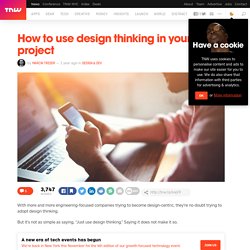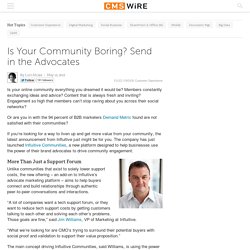

21 Content Marketing Predictions for the 2nd Half of 2015. How to use design thinking in your next project. With more and more engineering-focused companies trying to become design-centric, they’re no doubt trying to adopt design thinking.

But it’s not as simple as saying, “Just use design thinking.” Saying it does not make it so. What exactly is “Design Thinking”? Let’s take a step back and hear from the man who helped shaped the methodology as it’s used today, Tim Brown of IDEO. As he writes: “Design thinking can be described as a discipline that uses the designer’s sensibility and methods to match people’s needs with what is technologically feasible and what a viable business strategy can convert into customer value and market opportunity.” “Design thinking” is really just another way of saying “problem-solving.”
Photo credit: Design management. Got it? In this post, we’ll walk you through how to put design thinking into practice so that you can drive your project forward. The Parts of Design Thinking Photo credit: Marcin Treder Empathy: This is one of the indispensable traits of a designer. 3. Media Intelligence, Media Monitoring & Social Media Monitoring. Is Your Community Boring? Send in the Advocates. Is your online community everything you dreamed it would be?

Members constantly exchanging ideas and advice? Content that is always fresh and inviting? Engagement so high that members can’t stop raving about you across their social networks? Or are you in with the 94 percent of B2B marketers Demand Metric found are not satisfied with their communities? If you’re looking for a way to liven up and get more value from your community, the latest announcement from Influitive just might be for you. More Than Just a Support Forum Unlike communities that exist to solely lower support costs, the new offering – an add-on to Influitive’s advocate marketing platform – aims to help buyers connect and build relationships through authentic peer-to-peer conversations and interactions. “A lot of companies want a tech support forum, or they want to reduce tech support costs by getting customers talking to each other and solving each other’s problems. “Community is an understood space,” he said. Why It Might Be Time to Completely Change Your Social Media Strategy.
Why It Might Be Time to Completely Change Your Social Media Strategy I recently delivered the closing keynote at the Social Fresh Conferencein Orlando (the next Social Fresh — a conference I very much endorse — is in October in San Diego).

My presentation was called “Shotguns Trump Rifles: Why Social Success is Now a Volume Play” and was one of most controversial talks I’ve ever given about social media strategy. I’ve embedded the slides and video below, and I do hope you’ll spend a few minutes now (or download for later) because this issue impacts every single person using social media strategy for business.
Shotguns trump rifles: Why social media strategy is now a volume play from Jay Baer (Above) Here’s the summary of why we all need to consider adopting the shotgun methodology: Social media offers your brand reach, but today’s social media is terrible at reliable reach. Email has reliable reach. In the everyone is a publisher world, the communications cacophony is simply staggering. 8 Ways to Use Social Media to Drive Engagement. Social selling.

Sounds good, right? Millions of modern marketers from around the globe are discovering that they can use digital channels to reach their buyers online. Sounds simple, obvious really. “We’ll use LinkedIn, Twitter, Facebook to post information and images about what we do and they will flock.” But is it really that easy or is this a rerun of Field of Dreams? Build it and they will come has never panned out online. Recommended for YouWebcast: Relationship Marketing: How to Build a Relationship that Converts to Sales Yet, we are at it again building social selling campaigns and pushing out images and information in hopes someone will see it. Let me remind you, this approach will not work. Marketing and sales need to flip the megaphone around in order to fully listen and respond from a place of genuine helpfulness and thought leadership. But who has time for trust building –asks the sales professional who is under pressure to perform? It is a nuanced skillset. 1.) 2.) 3.) 4.) 5.)